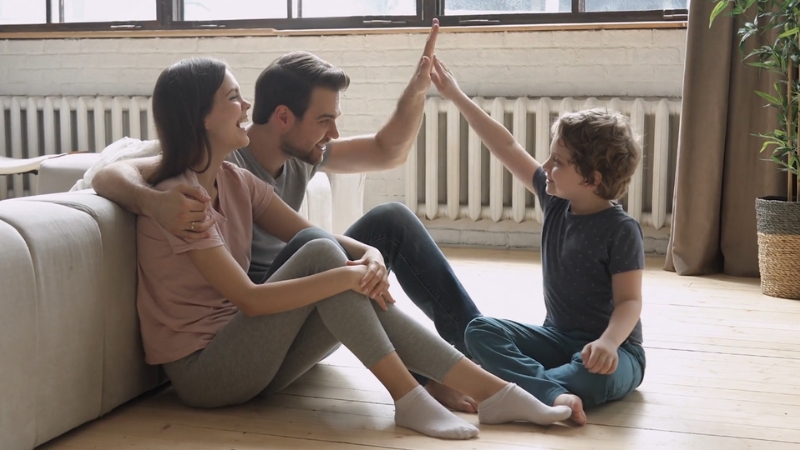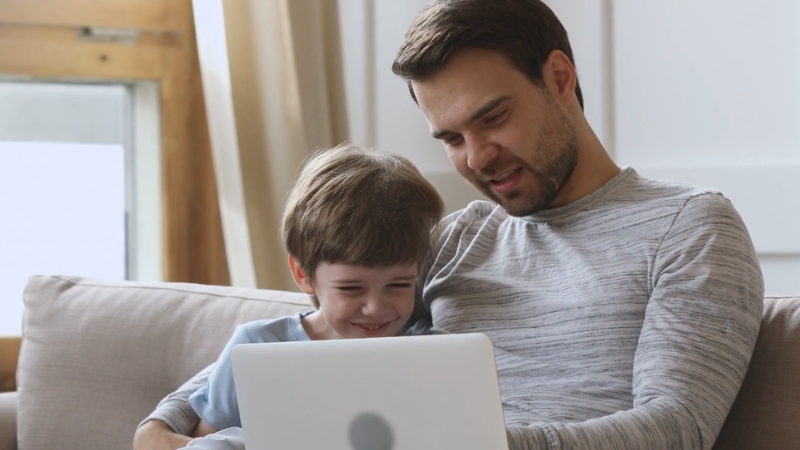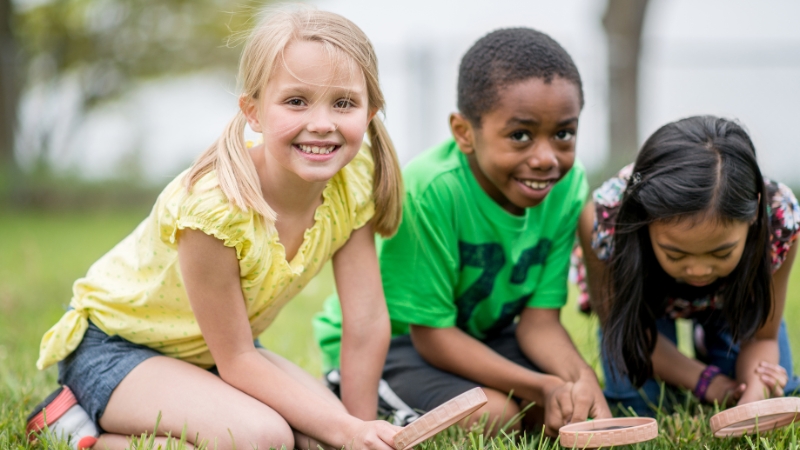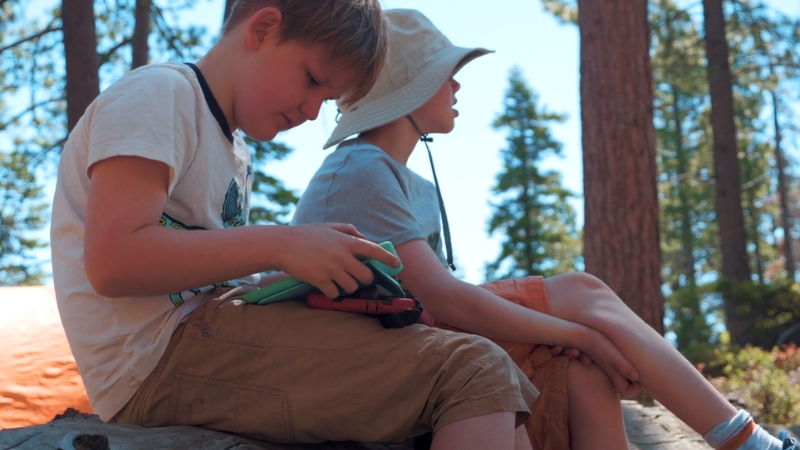Preparing your child for their first summer camp is about more than checking off a packing list—it’s about making sure they’re physically, mentally, and emotionally ready for an active, social, and sometimes unpredictable environment.
Whether the camp is for a weekend or two full weeks, kids will be navigating group schedules, outdoor activities, and personal responsibility—often for the first time without you around.
The key to success? Start early, be intentional, and practice the basics.
From building stamina for long hikes and swims to rehearsing self-care routines like sunscreen and showering, preparation helps turn nervousness into confidence. Kids who arrive with a bit of structure already in place tend to adjust faster, enjoy camp more, and come home with great memories instead of complaints.
1. Gauge Emotional Readiness Early

Before you worry about hiking boots and bug spray, check that your child is emotionally on board.
Mini-sleepover test. Has your child comfortably stayed with relatives or close friends overnight? A positive experience is a strong predictor of camp success.
Discuss realistic scenarios. Talk about homesickness, sharing bathrooms, trying new foods, or sleeping in cabins. Normalizing common camp hurdles reduces anxiety.
Let them help choose the camp. Kids who feel ownership over the decision—perhaps because it offers archery, drama, or robotics—arrive motivated rather than apprehensive.
2. Build Physical Stamina and Body Confidence
Even “relaxing” camps pack the day with swimming, hikes, and games that can leave an unprepared child exhausted or injured.
Leg injuries, especially in the knees and ankles, are common when kids jump into intense activity without building strength or balance first.
Start a low-pressure conditioning routine four to six weeks before departure.
Common Camp Activity
Why It Fatigues Kids
Easy At-Home Prep (3×/week)
Trail hikes
Uneven terrain, uphill climbs
Evening family walks gradually extended from 20 → 45 minutes
Lake or pool swim
Continuous laps, cold water
Neighborhood pool visits; practice treading water 1–2 minutes
Capture-the-flag
Sprint-stop-pivot movements
Backyard shuttle runs; hopscotch for agility
Canoeing
Repetitive upper-body motion
Simple resistance-band rows, plank holds
Schedule a pre-camp physical. Many camps require one, and it’s your chance to update vaccinations, refill inhalers, or address orthopedic concerns.
3. Teach Personal Health & Safety Habits
Camp isn’t just about hiking trails and swimming in lakes—it’s also about navigating physical autonomy. For many kids, this is the first time they’ll need to manage their own bodies’ needs without direct reminders from parents.
That means knowing when to hydrate, how to protect their skin, and what to do if something doesn’t feel right.
This kind of readiness isn’t about conditioning—it’s about bodily awareness and habit training. And it starts at home, weeks before the campfire is lit.
Hydration Awareness
One of the most common issues on day one of camp is dehydration, especially among younger kids who are distracted or hesitant to ask for water breaks. Teach your child the “color-check rule”: if their urine isn’t pale yellow, it’s time to drink more water.
To build this into a habit, have them keep a reusable water bottle on hand during after-school activities and get used to taking small sips throughout the d, y—not just when they feel thirsty.
Sunscreen Independence
Most camps will remind kids to apply sunscreen, but the follow-through often depends on the child. Get them used to the 20-minute rule: apply sunscreen before leaving the cabin, and reapply after lunch or swimming—even if it’s cloudy.
Let your child practice using spray or lotion types at home, and explain why sunburn makes physical activity harder (it drains energy and makes sweating painful).
Insect and Tick Awareness
Spending time in wooded areas means tick checks become a daily necessity, not an occasional one. During spring hikes or weekend park visits, teach your child how to inspect behind the knees, inside elbows, along the hairline, and around ankles.
If they can master this routine before camp, they’ll treat it like brushing their teeth—second nature.
Medication & Body Signals
If your child takes regular medication, now’s the time to build confidence in self-reporting and timing. Use a segmented pill case and role-play scenarios where they explain their schedule to a camp nurse.
More broadly, teach them to listen to their body—what dehydration feels like, how to describe a headache or stomach ache, or when to speak up about a scrape, rash, or strange insect bite. These aren’t just health issues—they’re life skills.
Water Readiness (Not Just Swimming)
Even if your child has basic swim ability, camp adds variables—cold water, murky lakes, and group activities. Confidence in water is a huge asset.
Schedule a few private lessons or weekend swims in less controlled environments, like open water or unfamiliar pools. Teach them to float, tread water for one to two minutes, and calmly get in and out of the water without rushing.
If your child’s nervous, reassure them: swimming strength is a skill, not a personality trait, and it improves with practice, not just bravery.
4. Master the Packing Game—Together
@taryn.newton Getting packed for a week long camp! #momlife #packwithme #summercamp #packingtips #momof5 #familytravel #momtips ♬ original sound – Taryn Newton
Packing for camp isn’t just a checklist—it’s a valuable learning experience for kids. When you let your child help, you’re not just preparing their suitcase—you’re preparing them for a week of independence and self-reliance.
Start by reviewing the camp’s official gear list together. Then go through each item one at a time, explaining not just what to pack, but why it matters.
For example, talk about how moisture-wicking socks help prevent blisters after long hikes, or how quick-dry shirts are better for humid days at the lake than cotton ones that stay soggy.
Here’s a more complete breakdown of essentials your child should understand and be involved in packing:
Item
Why It Matters
7–10 pairs of moisture-wicking socks
Keeps feet dry and blister-free during active days
5–6 quick-dry shirts & shorts
Easy to wash and fast to dry if they get wet or dirty
2 swimsuits
One can dry while the other’s in use for lake, pool, or shower use
Wide-brim hat & sunglasses
Protection from sun exposure during midday activities
Flashlight or headlamp + batteries
Navigating bunkhouses or late-night bathroom trips
Laundry bag (labeled!)
Keeps dirty clothes separate and cuts down on clutter
Label everything. Seriously—every sock, towel, and water bottle. Use fabric-safe permanent markers, iron-on name labels, or pre-printed tags. Camps are notorious for lost-and-found piles, and a simple name label can save time, stress, and your money.
Also, choosing the perfect size duffle bag makes a huge difference. A small, overstuffed bag means kids end up sitting on it just to close it, while an oversized one turns bunk beds into chaos. Aim for a soft-sided 60–70-liter bag—roomy enough for gear, but compact enough to store under a bunk or at the foot of a bed.
And finally, pack together. This helps your child learn what they have and where it is—so when they can’t find their flashlight on night two, they won’t panic.
5. Practice Key Life Skills Before Departure

This step is particularly important if your child has been learning at home through an accredited online schools K-12.
While these programs offer strong academic structure and flexibility, children in virtual K–12 environments may have less exposure to daily social routines—things like using group bathrooms, managing personal belongings in shared spaces, or navigating cafeteria-style dining.
These small but important interactions are central to camp life, where teamwork, personal responsibility, and unstructured social time are woven into everyday life.
If your child is used to the predictability and solitude of a home-based learning environment, it can help to create social readiness opportunities before camp begins. Arrange low-stakes group settings like library workshops, community art classes, or sports practices.
These give your child a chance to practice taking turns, resolving small conflicts, and reading group dynamics—skills they may not encounter often in a fully online K–12 schedule.
By preparing them for both the practical and interpersonal sides of camp, you help them feel more confident stepping into a bustling, screen-free environment filled with new faces and shared adventures.
6. Plan Communication & Manage Homesickness
For many families, this is the most emotionally loaded part of camp preparation: how to stay in touch without overdoing it, and how to help your child cope when those inevitable feelings of homesickness creep in.
Start by explaining that limited communication is part of the adventure. Most camps restrict phone access to help kids fully engage with their environment and build resilience. Let your child know that feeling a little nervous or missing home is normal, and that almost everyone feels it at some poi, t—but that those feelings usually fade once the fun begins.
If the camp offers structured contact options (like one scheduled phone call or a parent email box that staff read to campers), go over these expectations in advance so there are no surprises. Help your child write a list of things they might want to share when it’s time to check in—like what they ate, a new game they learned, or someone they met in their cabin.
Pack a comfort item that feels familiar but subtle. A small stuffed animal, a photo of the family, or even a laminated card with an encouraging message can be enough to make tough moments feel more manageable. For older kids, a journal can be a private way to work through feelings when a counselor isn’t immediately available.
Most importantly, normalize mixed emotions. Say something like: “Itly okay to feel both excited and nervous. That’s how you know you’re about to do something new and amazing.”
7. Check-Out Day Prep: Looking Ahead

While your focus might be on getting your child ready to leave for camp, don’t forget to prep them for the return home as well. Setting clear expectations about what happens after camp can help ease the transition and give kids a comforting sense of closure.
Explain that there will be laundry to do, stories to share, and maybe even some time needed to rest and readjust. Some kids come back bursting with tales from archery class or talent night. Others might feel quiet and tired after a full week of stimulation. Let your child set the pace.
Consider encouraging a thank-you note or drawing to their favorite counselor. This not only reinforces gratitude, but helps your child reflect on what they gained from the experience—new friends, independence, or maybe even a new favorite food they tried in the mess hall.
Final Thoughts
Packing for camp, building life skills, preparing for limited contact, and looking ahead to the return home—these all play a vital role in making your child’s first summer camp experience a success. Whether they come from a traditional school background or an online elementary school setup, every child can benefit from this mix of structure, adventure, and self-growth.
By walking them through the process step by step—and letting them practice, participate, and take ownership—you’re not just sending them to camp. You’re sending them forward in life with a little more confidence than they had before.
Related Posts:
- How Can You Start a Career as a Running Coach?
- How Long Does It Take to Train for a Half Marathon?
- Lower Back Pain While Running? Here's What You Need to Know
- How Far Is a Half Marathon? Everything You Need to Know
- Tendonitis, Shin Splints, and Other Common Leg…
- 10 Best Running Documentaries - Inspiring Films for Runners







